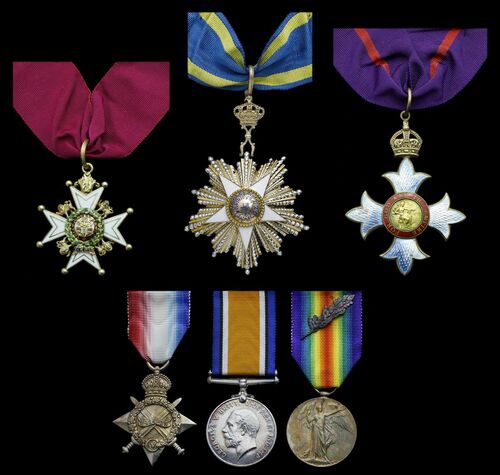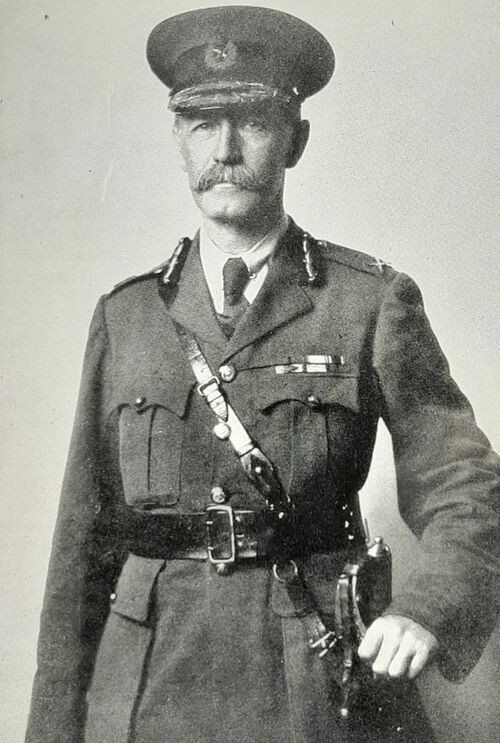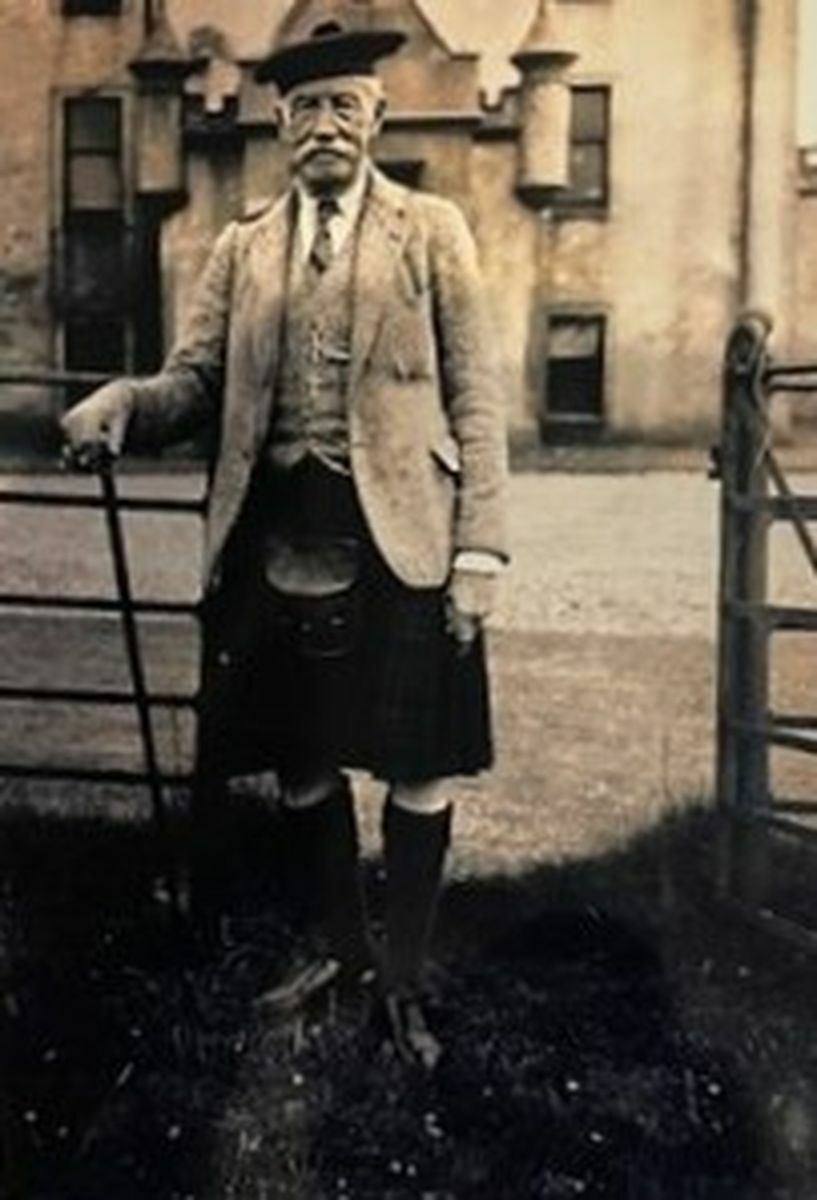Auction: 24002 - Orders, Decorations and Medals
Lot: 190
Sold by Order of a Direct Descendent
The superb 'Gallipoli 1915' C.B., 'Great War' C.B.E., group of six awarded to Brigadier-General E. M. P. Stewart, Laird of Coll, Royal Engineers, who served as Director of Works for the British Army in Egypt and Palestine, having responsibility for the Royal Engineers during the Third Battle of Gaza; becoming the Laird of Coll post-war he was a Lieutenant in the Home Guard during the Second World War but sadly died of ill-health in 1942
The Most Honourable Order of the Bath, Military Division, Companion's (C.B.) neck Badge, gold and enamel; The Most Excellent Order of the British Empire, Military Division, Commander's (C.B.E.) neck Badge, silver-gilt and enamel; 1914-15 Star (Lt: Col E. M. Paul. R.E.); British War and Victory Medals (Brig. Gen. E. M. Paul.), with M.I.D. oak leaves, enamel wear to second, minor contact marks to campaign awards, overall very fine (6)
Ernest Moncrieff Paul (later changed to Stewart) was born at Sydney, Victoria on 2 September 1864, the son of Henry and Emily Paul of Glasgow who had emigrated to Australia earlier in the decade. The younger Paul lived his first few years in Australia before his father returned to Britain for work as the Manager of the New Zealand Loan and Mercantile Agency in London. Educated at King's College School, London and later Marlborough College he joined the Royal Indian Engineering College at Coopers Hill in 1883.
Pre-War Career
Studying there until December 1885, Paul left in a year when several commissions were being offered by Royal Engineers and he was one of those number. He was directly commissioned Lieutenant into the Corps on 6 January 1886 and joined the School of Military Engineering where he studied for two years. Elected for Indian Service he was ordered to the Military Works at Barrackpore as Assistant Engineer and appointed Executive Engineer at Allahabad in 1891 and Rangoon in 1892.
While there he married Katherine Coldstream at Simla on 25 April 1893 and was selected as an Assistant Instructor in the Construction School of the School of Military Engineering. Advanced Captain on 12 August 1895 he served for five years with the S.M.E. before becoming Division Officer at Harwich to oversee the new defence works.
Posted to Gibraltar in 1900 he was appointed to command the 49th Company, Royal Engineers and further promoted Major on 21 December 1903. This first taste of command was not to last long however, and Paul was posted back to the S.M.E. in 1904 as Instructor in Estimating and Construction, a role he was to hold until 1908. While there Paul was also to become qualified in Russian and publish a number of technical pamphlets.
Appointed Major of the Royal Engineers Training Battalion he was given command of the formation for some time in 1910. This was followed by a position as Commander Royal Engineers, Colchester, a position which carried with it the appointment as Commander Royal Engineers 4th Division, B.E.F., an outfit which was still being formed at the time. In recognition of this role Paul was promoted Lieutenant-Colonel on 1 October 1911.
The Great War
Paul was next appointed Commander Royal Engineers, Ceylon in 1912 a role he was undertaking when the Great War began in 1914. As such his work in the early months of the conflict was almost entirely related to the defence of the Island from the German East Asia Squadron and later the S.M.S. Emden.
The Battle of Cocos effectively ended any such threat and as such Paul was transferred to the Dardanelles to undertake the role of Deputy Director of Works with the local rank of Colonel. Appointed Director of Works on 23 November 1915 he was advanced Brigadier General to provide him with seniority for the role. This was an unfortunate time to succeed to the position as before long he was called upon to provide the Engineers support for the evacuation of Suvla and Anzac beaches.
Having completed this task Paul withdrew to Egypt where in February 1916 he joined the headquarters of the Mediterranean Force under General Sir Archibald Murray, again as Director of Works. In this role he was responsible for all the work undertaken by the Royal Engineers in Egypt, The Western Desert, the Suez Defences, Salonika and Cyprus. That latter responsibility was greater than it appeared as it was the location of a great many prisoner of war camps, the Engineers were also responsible for the maintenance of the R.F.C. aerodromes and the R.N.A.S. station at Mudros.
A restructuring of the Engineering services in the east led to Paul's remit being reduced from August 1916, he became responsible for all the districts in Egypt that were not combat zones. Unfortunately, this solution proved to be unworkable and he was increasingly pulled into active fighting areas to perform his duties. The fighting at the time around Gaza presented a great many logistical challenges with none so pressing as the provision of water, for which Paul and his counterpart the Engineer-in-Chief Colonel H. B. H. Wright were responsible.
During the run up to the crucial Third Battle of Gaza, his opposite number Colonel Wright was on leave and Paul was in charge of the of the Operational areas. Allenby had advanced the date of the attack to outfox the Turks, a move which meant that Colonel Wright was still away when the attack began. Not only did this give Paul an enormous amount of work in the run up to the battle but also gave him responsibility for the housing of the large number of prisoners taken afterwards. Accommodation had been prepared for 60,000 when in fact there were 98,840.
While he maintained the role of Director of Works Paul wrote a number of letters to his superior Major-General Scott-Moncrieff at the War Office. These superbly detailed accounts, illustrated by over 600 pictures remain a valuable source of information on the war in the Middle East and were referred to, by kind permission of their author, as the 'Pauline Epistles'.
Post-War
After the collapse of the Ottoman Empire and their withdrawal from the war Paul was appointed Chief Engineer in Egypt, a role he undertook until June 1919 whereupon he returned to Britain. Joining the War Office as Deputy Director of Fortifications and Works on 3 September 1919 during which he visited Ireland to advise on housing the increased Garrison during the War of Independence.
Retiring in 1921 he settled in Kensington and undertook a great programme of travelling, becoming a member of the Royal Geographic Society. During this period Paul was working for the Intelligence Branch of the War Office and his visits to Central Asia, Russia and North Africa doubtless provided them with abundant useful information.
Inheriting the Island of Coll, off Argyllshire from his cousin Charles Stewart he changed his name to Stewart and took up residence in Breachacha Castle. On the outbreak of the Second World War he formed a local Home Guard unit with the rank of Lieutenant, although it must be noted that at the time Coll had a population of only 100. Nevertheless he took his duties seriously and it may have been this strain which caused him to fall ill, closing the castle he returned to Kensington where he died of bronchitis on 11 April 1942.
Paul was survived by his son Colonel H.W.M. Paul, O.B.E., M.C. who was taken prisoner while commanding 1st Middlesex Battalion in Hong Kong, Captain G. A. M. Paul, Royal Navy (see Lot 112), C.S.T. Paul a Civil Engineer and J.S.M. Paul, Sudan Government Service. As well as a daughter E. M. Cameron (Nee Paul) but was predeceased by his son 2nd Lieutenant E. K. M. Paul, M.C., Royal Garrison Artillery who was mortally wounded at Ypres in 1918.
After his death Paul was remembered by Lieutenant-Colonel J. S. Yule, Royal Engineers, historical section, who stated:
'Paul's work in Egypt was a fitting climax to the preparations of a lifetime. To the young Officer who heard his lectures at Chatham there appeared the balance between the soldier and the engineer, and if Paul himself inclined to the engineering side, it was always to study how civil engineering could serve the needs of an army in the field. What he advanced in theory at Chatham he put into practice in Egypt… He was no respecter of persons; he talked to Lord Milne and Lord Allenby as man to man. He was trusted'
Sold together with an original Memoir reprinted from The Royal Engineers Journal December 1942 and copied research including census data, Army Lists and Civil Engineer Records.
Subject to 20% VAT on Buyer’s Premium. For more information please view Terms and Conditions for Buyers.
Sold for
£2,000
Starting price
£1200









